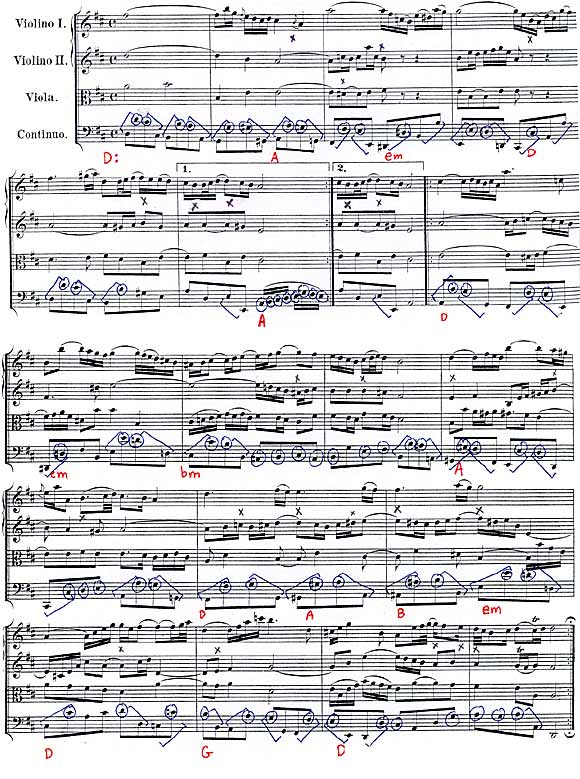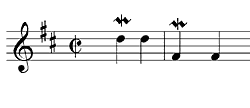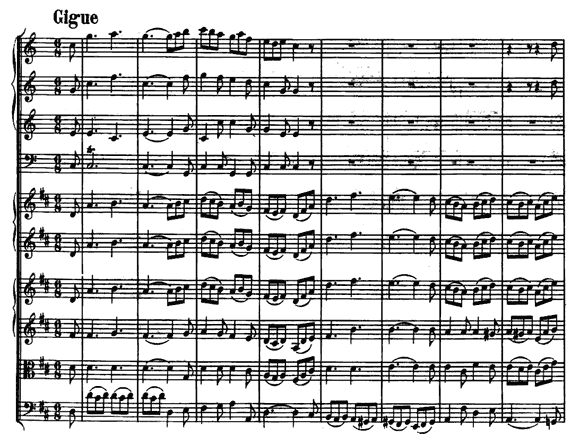Of Bach’s four orchestral suites the third is the best known, largely due to the fame of the second movement, the famous “Air for the G string.” The third suite, in D major, consists of five movements: overture, air (strings and continuo only), gavottes I & II, bourrée, and gigue. All movements except for the air are scored for three trumpets, timpani, two oboes, strings, and continuo. The oboes rarely play independently of the violins in this work. The trumpets and drums are used for color and emphasis. Typical of Bach’s suites, this one consists of mostly binary movements (two-part forms) based on French dances.
Overture
All of Bach’s orchestral suites begins with a French overture. Here, the slow, majestic music returns at the conclusion of the fast portion, with a repeat to the beginning of the fast section. If you look at a copy of the score you might be surprised to see that the timpani part is in C major. Is the timpani really playing in a different key? No, but since the timpani of Bach’s day weren’t tunable, like today’s instruments, all timpani parts were written as though they are playing in C major. The pitch “C” is always equivalent, in this time, to the tonic pitch of the key, here D; the pitch “G” is always equivalent to the dominant pitch of the key, here A. Thus, the timpani could only play when the music was in the tonic key (D major), not when it modulated to other keys (this overture also goes to A major, E minor, b minor, G major). So even if you don’t have a score, or can’t read music, you can tell when the music of this piece is in D because of the timpani. (The trumpets, by the way, are only marginally more flexible in terms of the key; they most often play when the piece is in D major as well.)
Air
Is there a more famous piece from the Baroque era than this one? A more famous piece for strings alone from any time? Perhaps not, and some readers might think that there’s no point in discussing this movement at length, since everyone knows how it goes. But I find this movement fascinating for the density of material in what is a mere eighteen measures.
First, let me tell you about the title of the movement. An “air” is in fact not a French dance, as are the other movements. Clearly, it is an English term, the English term for “aria” or any lyrical work, as this is. As he usually does in the slow movements of his Brandenburg Concertos, Bach drops out the wind instruments and timpani here, allowing the strings alone to carry all the material.
This is a simple binary piece; there is clearly no return of the opening melodic material in the second part of the movement.
The movement is sometimes called the “Air for the G string” because when it is transposed to C major the entire first violin part can be played on the G string alone; the 19th century German violinist August Wilhelm did this in his transcription of the work for violin and piano.
I’d like to point out a few interesting items in the score, which you can observe below.
- The letters in red indicate the key involved at the time; all the keys are closely related to the original D major. Capital letters indicate major keys; lower case indicates minor (followed by “m”, just to be sure).
- The bass line is a typical Baroque walking bass line, which is in constant motion. But look at how deceptively simple the content of this line is; it’s really just octave leaps (marked with a bracket) or step-wise motion, as if moving through a scale (marked with circles).
- While most people sit back and enjoy the lovely melody, it’s actually the combination of the parts which makes this piece so delicious. And you might be surprised to find out that the combination of parts results occasionally in some very surprising dissonance. Most of the dissonances in this work are a result of a sustained part clashing with a moving part, especially in the form of a suspension. In Bach’s day, suspensions were classified according to the dissonant-consonant interval combination: 4-3 (a fourth resolving to a third), 2-3 (a second resolving to a third), 7-6 (a seventh to a sixth), and 9-8 (a ninth to an octave). Some, but not all, of the dissonant moments are marked with an x in the score below. Additional dissonances are the result of non-chord tones (pitches not belonging to the prevailing harmony at the moment), such as appoggiaturas.
- Finally, notice how the motion is continuous from start to end with two exceptions: the two strongest cadences, at the end of the first section (second ending) and the final measure. Otherwise, this is another example of “perpetual motion” in Bach’s works, though because of the slow tempo we tend to forget that. (Look at the combination of parts, not individual parts, to realize the perpetual motion effect.

Gavotte I & II
The gavotte traces its history back to the late 16th century, and continued as a popular courtly dance form to the end of the 18th century. Bach wrote 26 pieces he titled “gavotte”, including movements in three of the four orchestral suites. A gavotte is a stylized French dance, moderate in tempo, always in duple meter, with each phrase beginning half-way through a measure. The phrases are almost always groups of four measures each, and are often paired in an antecedent-consequent manner. Like the air, it is a binary form, with two repeated sections. It is graceful, sometimes joyful, but not as romping and raucous as a gigue (discussed below).
In this case, there are actually two separate gavottes, each a binary form, each in D major. Gavotte I is a simple binary form in D major, with a modulation to A (the dominant) at the end of the first section, and a move to b minor (the relative minor key) near the start of the second portion. The entire piece is based on a simple four-note motive:

Sometimes the rhythm is varied as follows:

This rhythm and its variation pervade the entire gavotte I from beginning to end.
Gavotte II is a little longer, by a mere six measures. It reverses the second rhythm of Gavotte I by putting the eighth notes first:

Putting this eighth-note neighboring tone figure first, before the longer quarter note, Bach makes the music sound more ornamented, since this type of pitch movement was common to the mordent, an ornamental figure in the Baroque era. Mordents are particularly common in keyboard music, but also appear in other instrumental music. Here’s what the passage above would look like using mordents instead of written-out eighths:

(FYI: A mordent in which the neighboring tone was ascending (D-E-D, for example) would be missing the vertical line in the middle.)
After the Gavotte II is played in its entirety,the convention of the time was to repeat Gavotte I, skipping the repeats. This results in an overall ABA form, seen in other dance forms of the time as well.
Bourrée
Like the gavotte, the bourrée was a French courtly dance. It is in duple meter, usually moderate to quick in tempo (slightly faster than the gavotte), and always beginning with a quarter-note (or two eighth notes) pick-up. Like the gavottes discussed above, the phrases are usually four measures in length, and often arranged in an antecedent-consequent fashion. All four orchestral suites use a bourrée. Atypical of most bourrées, Bach in this example experiments a bit with syncopation in the second portion of the movement:

It’s not exactly jazz, but this is unusual for a bourrée, where the rhythm almost never obscures the strong beats. At this same moment, Bach shifts the music to the minor mode, and the combination of the rhythm and modality is unsettling.
Gigue
In its various guises, the gigue (aka: jig, jigg, giga, or gique) appears forty-two times in Bach’s works. What they all have in common is the use of compound meter, a fast tempo, and a romping style. According to Meredith Little and Natalie Jenne (in Dance and the Music of J.S. Bach, [Bloomington: Indiana University Press, 1991]}, there are three basic types of gigues in Bach’s works: the French gigue, giga I and giga II. You may check out their descriptions of all three sub-genres at your leisure. This particular gigue Little and Jenne classify as an example of giga I. Here are the characteristics of such a work (the items in bold can be found in the excerpt of the score below):
- Compound Meter
- Unpredictable phrase lengths
- Balanced phrasing at the beginning of sections
- Lively affect
- Imitative texture (some are actually fugal)
- One or two (as here) beats per measure
- Slower tempo with the illusion of fast (the individual eighth notes go fast, but the beat is a dotted-quarter, and thus not actually as fast as the piece might appear)
- Some ornamentation
- No harmonic change within triple groups (chord staying the same for the whole beat)
- usually slurs three-note groupings
- Few internal cadences (clear points of repose) before the ends of sections
- Jagged rhythms, especially in the upper voice (violins often have quarter-eighth rhythm) [Quite prevalent in the bass line of this piece]
- Binary form

You can’t really appreciate the irregular phrasing from what you see above. In the excerpt you do find balanced phrases to being the section (four measures plus four measures). The next phrase is also four measures in length; thus Bach sets up the expectation of 4+4 ad infinitum. But the phrase which begins in m. 13 does really at m. 24, twelve measures later, at the end of the first portion (at the repeat) – thus, it is an unpredictable phrase length.


































